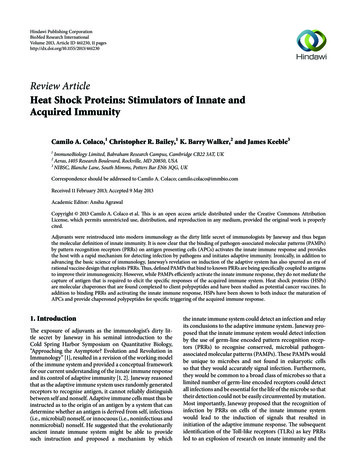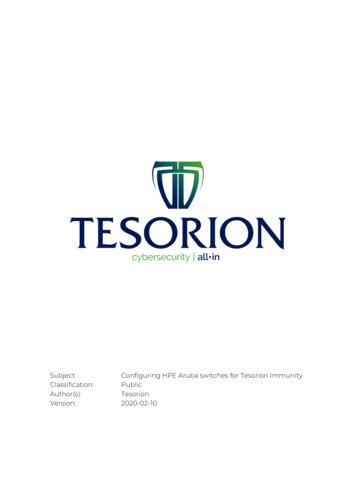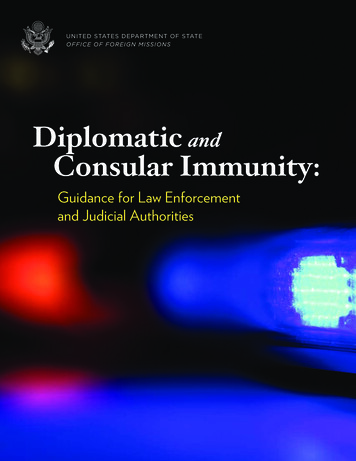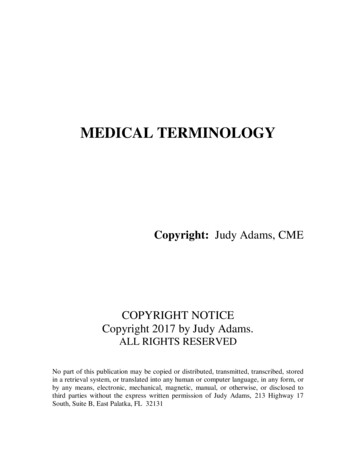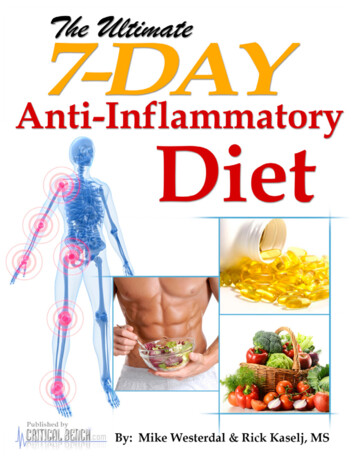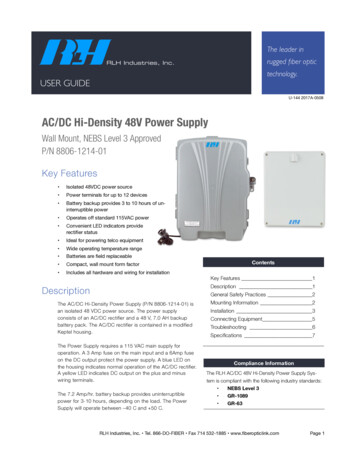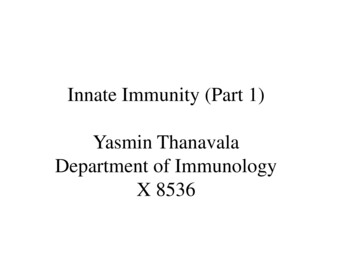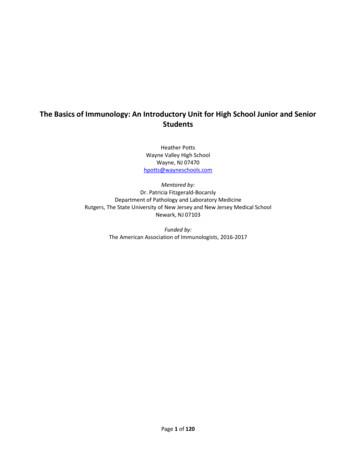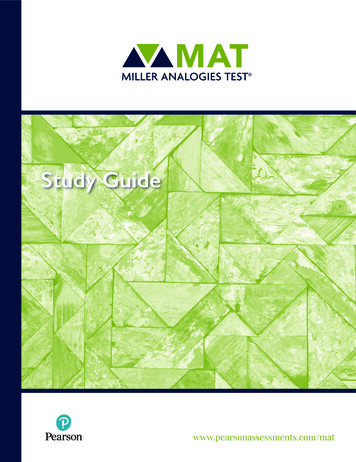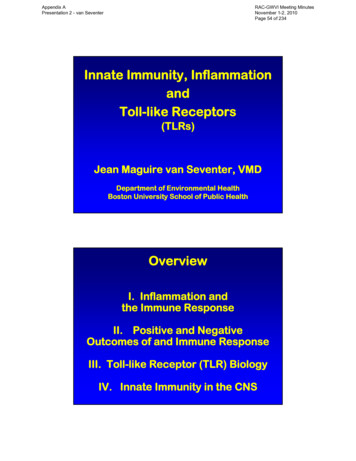
Transcription
Appendix APresentation 2 - van SeventerRAC-GWVI Meeting MinutesNovember 1-2, 2010Page 54 of 234Innate Immunity, InflammationandToll-like Receptors(TLRs)Jean Maguire van Seventer, VMDDepartment of Environmental HealthBoston University School of Public HealthOverviewI. Inflammation andthe Immune ResponseII. Positive and NegativeOutcomes of and Immune ResponseIII. Toll-like Receptor (TLR) BiologyIV. Innate Immunity in the CNS
Appendix APresentation 2 - van SeventerRAC-GWVI Meeting MinutesNovember 1-2, 2010Page 55 of 234OverviewI. Inflammation andthe Immune ResponseII. Positive and NegativeOutcomes of and Immune ResponseIII. Toll-like Receptor (TLR) BiologyIV. Innate Immunity in the CNSImmune SystemA system of defensesby which the body(host)recognizes self from non-self(foreign material)The immune systemdestroys or neutralizesforeign matter, both living and nonliving.
Appendix APresentation 2 - van SeventerRAC-GWVI Meeting MinutesNovember 1-2, 2010Page 56 of 234White Blood Cells are Mediators ofthe Immune ResponseWhite CellsWhite Blood Cell Lineages
Appendix APresentation 2 - van SeventerRAC-GWVI Meeting MinutesNovember 1-2, 2010Page 57 of 234The Immune Responseto Infectious PathogensInfectious Pathogenscutaneous/mucosal membraneParasitic worms Extracellular bacteria,(extracellular)parasites, fungiIntracellular ne ResponseAdaptiveImmune Response
Appendix APresentation 2 - van SeventerRAC-GWVI Meeting MinutesNovember 1-2, 2010Page 58 of 234Both Innate and Adaptive Immunity Depend on theActivities of White Blood CellsInnateImmune ResponseneutrophilsmacrophagesAdaptiveImmune Responsedendritic cells“DC”lymphocytesB cellT cell
Appendix APresentation 2 - van SeventerRAC-GWVI Meeting MinutesNovember 1-2, 2010Page 59 of 234InnateImmune ResponseAdaptiveImmune Response- Immediate response0-96 hours- Gradual response 96 hours-Targetsgroups of pathogens-Targetsspecific pathogens- No Memory- MemoryThe Immune ResponsePathogenic MicrobesParasitic worms(extracellular)Extracellular bacteria,parasites, fungimacrophagescutaneous/mucosal membraneIntracellular simmaturedendritic cellsB cellmonocytesT cellInnate Immune Responselymph nodeAdaptive Immune Response
Appendix APresentation 2 - van SeventerRAC-GWVI Meeting MinutesNovember 1-2, 2010Page 60 of 234Innate ImmunityThe First Line of DefenseInnate Immune Cells
Appendix APresentation 2 - van SeventerRAC-GWVI Meeting MinutesNovember 1-2, 2010Page 61 of 234Recognition of Pathogensby Innate Immune Cellsinitiated when innate immune cellPattern Recognition Receptorsincluding Toll-like receptors (TLRs), Nod-likereceptors (NLRs)and RIG-like receptors (RLRs)are triggered by microbe-specific motifs,Pathogen-Associated Molecular Patterns(PAMPs)Events Elicited by Triggering ofMacrophage and Neutrophil TLRs phagocytosis secretion of inflammatory cytokines secretion of chemokines (chemoattractants);recruitment of additional innate immune cells
Appendix APresentation 2 - van SeventerRAC-GWVI Meeting MinutesNovember 1-2, 2010Page 62 of 234Ilya Ilich (a.k.a. Elie) MechnikovFirst Observed Phagocytosis by Phagocytesa fundamental process of the innate immune ytosisMicrobe or other foreign material taken up by endocytosisand isolated and destroyed within a phagolysosomeVander’s Human Physiology. The McGraw-Hill Companies, Inc. , Editors
Appendix APresentation 2 - van SeventerRAC-GWVI Meeting MinutesNovember 1-2, 2010Page 63 of 234Agents produced or released byphagocyteson ingestion of microorganismsAcidificationpH 3.5-4.0 bacteriostaticbacteriocidalToxic O2-derived productssuperoxide O2- H2O2hydroxyl radical OH Toxic nitrogen oxidesnitric oxide NOAntimicrobial peptidesdefensins cationic proteinsEnzymeslysozyme acid hydrolasesCompetitorslactoferrin (binds Fe)vitamin B12-binding proteinSecretion of InflammatoryCytokines and Chemokines
Appendix APresentation 2 - van SeventerRAC-GWVI Meeting MinutesNovember 1-2, 2010Page 64 of 234Cytokines secreted in response to an activating stimulus stimulate cellular effector functions(eg. bacteriocidal activity of macrophages) induce responses by binding to specific receptorsautocrine actingparacrine actingendocrine actingChemokines class of cytokines chemoattractant properties induce cells with appropriate chemokinereceptors to migrate toward the chemokine source
Appendix APresentation 2 - van SeventerRAC-GWVI Meeting MinutesNovember 1-2, 2010Page 65 of 234Acute Inflammatory Events DuringInnate Immune Response to Infection1. Vasodilation of the microcirculation leading toincreased blood flow to the infected area2. Increased permeability of capillaries and venuleswith diffusion of blood proteins and filtration of fluidinto the interstitial spacesAbove events occur within seconds to minutes of infectionSubsequently 3. Chemotaxis with movement of leukocytes fromvenules into the interstitium of the infected area4. Destruction of pathogens in the tissues byphagocytosis and other mechanismsAcute Inflammationclassic signs and symptomsRednessHeatSwellingPain
Appendix APresentation 2 - van SeventerRAC-GWVI Meeting MinutesNovember 1-2, 2010Page 66 of 234InflammationBacteria triggermacrophages toreleasecytokines &chemokinesVasodilatiion andincreased vascularpermeability causeredness, heat &swellingInflammatory cellsmigrate into tissue,releasinginflammatorymediators causingpainAdapted from: Immunobiology . Janeway, Charles A.; Travers, Paul; Walport, Mark; Shlomchik, MarkNew York and London: Garland Science; c2001Important Cytokines Secreted byPathogen Activated Macrophagesinterleukin-1 (IL-1)interleukin-6 (IL-6)TNF-αinterleukin-12 (IL-12)interleukin-8 (IL-8)
Appendix APresentation 2 - van SeventerRAC-GWVI Meeting MinutesNovember 1-2, 2010Page 67 of 234Cytokine Secretion by Activated MacrophagesEndothelial activationVasodilationLymphocyte activationLocal tissuedestructionFeverHypotensionSHOCKIL-6 productionEndothelial activationLymphocyte activationChemotactic factorVasodilationIncreased antibodyproductionRecruitsneutrophilsT cellsIncreased vascularpermeabilityFeverMetabolites mobilizedSHOCKPromotesinflammatory Th1 cellgenerationActivates NK cellsFeverHepatic acute phaseprotein productionSHOCKAdapted from: Immunobiology . Janeway, Charles A.; Travers, Paul; Walport, Mark; Shlomchik, MarkNew York and London: Garland Science; c2001InflammationVander’s Human Physiology. The McGraw-Hill Companies, Inc. , Editors
Appendix APresentation 2 - van SeventerRAC-GWVI Meeting MinutesNovember 1-2, 2010Page 68 of 234Inflammation Associated with Strep ThroatNote the inflammation of the oropharynx and small red areas ofhemorrhage (petechiae).Strep throat is caused by group A Streptococcus bacteria which can spreadthrough direct contact with persons who are infected.Summary of the Innate Responseto an Invading Pathogenic Microbemacrophage TLRs and other pattern recognition receptorsbind pathogenic microbe motifs trigger macrophage tophagocytize and destroy infecting microbe activated macrophages secrete chemokines that attractadditional innate immune cells neutrophils & monocytesneutrophil primary cell seen early in response to pathogens phagocytize and destroy invading microbesmonocytes rapidly differentiate into macrophagesadding to the defenses
Appendix APresentation 2 - van SeventerRAC-GWVI Meeting MinutesNovember 1-2, 2010Page 69 of 234Adaptive ImmunityThe Backup Line of DefenseAdaptive Immune Cells
Appendix APresentation 2 - van SeventerRAC-GWVI Meeting MinutesNovember 1-2, 2010Page 70 of 234Antigenthat which is recognized bythe adaptive immune systemAntigen Binding Site ofAntibody and T-cell Receptor MoleculesImmunobiology . Janeway, Charles A.; Travers, Paul; Walport, Mark; Shlomchik, MarkNew York and London: Garland Science; c2001. http://www.ncbi.nlm.nih.gov/bookshelf/br.fcgi?book imm&part
Appendix APresentation 2 - van SeventerRAC-GWVI Meeting MinutesNovember 1-2, 2010Page 71 of 234Overview of LymphocyteActivation, Proliferation, Differentiationantigen stimulationresting naïveT cell & B celldifferentiationproliferationmemoryT cell & B celleffectorT cell & B cell(circulating)CD4 T helper cell(Th cell)CD8 cytotoxic T cell(CTL)plasma B cellantibody-producingimmaturemDCmDC maturationCTLAfferentlymphaticsTh cellEfferentlymphaticsLymph NodematuremDCplasma cellB cell differentiationT cell differentiationViral Antigen PresentationDC: dendritic cellAntibody productioneffector CTLmemory CTLnaïve Th cellTh cell: T helper celleffector Th cellmemory Th cellCTL: cytotoxic T cell (lymphocyte)B cell
Appendix APresentation 2 - van SeventerRAC-GWVI Meeting MinutesNovember 1-2, 2010Page 72 of 234Adaptive Immunityhas MemoryPlasma AntibodyConcentrationhighprimary responsesecondary responseinitial exposurereexposuresecond exposureto antigenfirst exposureto antigenlow0306090120150180Time (days)OverviewI. Inflammation andthe Immune ResponseII. Positive and NegativeOutcomes of and Immune ResponseIII. Toll-like Receptor (TLR) BiologyIV. Innate Immunity in the CNS
Appendix APresentation 2 - van SeventerRAC-GWVI Meeting MinutesNovember 1-2, 2010Page 73 of 234Positive Outcomes ofan Immune ResponseProtection from Infectious Disease(Positive Outcome) natural immunity protects from reinfection vaccination protects from primary infectionNegative Outcomes ofan Immune ResponseShock and Tissue DamageNegative Outcomes acute effects due to a“cytokine storm” / “cytokine surge”(endotoxic shock, SARS, Hanta, Dengue) chronic effects of cell mediatedgranuloma formation(Schistosomiasis) autoimmunity(Multiple Sclerosis, Systemic Lupus Erythematosus)
Appendix APresentation 2 - van SeventerRAC-GWVI Meeting MinutesNovember 1-2, 2010Page 74 of 234The Cytokine Storm Endotoxic ShockEndothelial activationVasodilationLymphocyte activationLocal tissuedestructionFeverHypotensionSHOCKIL-6 productionEndothelial activationLymphocyte activationChemotactic factorVasodilationIncreased antibodyproductionRecruitsneutrophilsT cellsIncreased vascularpermeabilityFeverMetabolites mobilizedSHOCKPromotesinflammatory Th1 cellgenerationActivates NK cellsFeverHepatic acute phaseprotein productionSHOCKAdapted from: Immunobiology . Janeway, Charles A.; Travers, Paul; Walport, Mark; Shlomchik, MarkNew York and London: Garland Science; c2001Chronic Schistosomiasiscontinuing infection causinggranulomatous reactions to schistosoma eggsandfibrosis in the affected organsEggGranulomaformationHost ResponseFibrosisCollagen DepositionTissue ScarringDiseaseCirculatory ObstructionOrgan malfunction
Appendix APresentation 2 - van SeventerRAC-GWVI Meeting MinutesNovember 1-2, 2010Page 75 of 234OverviewI. Inflammation andthe Immune ResponseII. Positive and NegativeOutcomes of and Immune ResponseIII. Toll-like Receptor (TLR) BiologyIV. Innate Immunity in the CNS
Appendix APresentation 2 - van SeventerRAC-GWVI Meeting MinutesNovember 1-2, 2010Page 76 of 234As early as 1989,Charles Janeway theorized thatthe innate immune system usedspecialized receptorsto recognize infecting pathogens.Approaching the Asymptote? Evolution and Revolution in ImmunologyC.A. Janeway, Jr.Establishment of dorsal-ventral polarityin the Drosophila embryo:genetic studies on therole of the Toll gene product.Anderson KV, Jürgens G, Nüsslein-Volhard C.Cell. 1985 Oct;42(3):779-89.
Appendix APresentation 2 - van SeventerRAC-GWVI Meeting MinutesNovember 1-2, 2010Page 77 of 234Toll Mutation Severely Reduces Survivalof Adult Flies after Fungal InfectionGerminating fungal hyphe on adrosophila deficient for aToll receptor geneLemaitre, B. Cell. 86 (6) 973-983
Appendix APresentation 2 - van SeventerRAC-GWVI Meeting MinutesNovember 1-2, 2010Page 78 of 234Toll Receptors best-defined pattern recognition receptors ofinnate immune system(others include Nod-like receptors [NLRs] and RIG-like receptors [RLRs]) Toll receptor stimulation triggers production ofanti-fungal peptides in response to fungal infections different Toll family members are involved inactivating an anti-bacterial and anti-viral responsesToll-like ReceptorsTLRsMammalian homologues ofdrosophila Toll receptors
Appendix APresentation 2 - van SeventerRAC-GWVI Meeting MinutesNovember 1-2, 2010Page 79 of 234Toll-like Receptors (TLRs)bacterial lipopolysaccharide, LPS cell-wall component of gram-negative bacteria can induce a dramatic systemic reaction known asendotoxic shockMutant Mice with TLR4 Gene Mutation unresponsive to bacterial lipopolysaccharide, LPScell-wall component of gram-negative bacteria protected from endotoxic shockPoltorak et.al. Science. 1998 Dec 11;282(5396):2085-8.
Appendix APresentation 2 - van SeventerRAC-GWVI Meeting MinutesNovember 1-2, 2010Page 80 of 234Human Toll-like ReceptorsTLRExogenous Ligand; PathogenTLR1tri-acetylated lipopeptides, porins;Gram positive and negative bacteriaTLR2lipopeptides, peptidoglycans, glycolipids,polysaccharides; virus, Gram positive bacteria, ded RNA (dsRNA); virusesLPS (lipid A); Gram- negative bacteriaflagellin; bacteriadi-acetylated lipopeptides; Gram positive bacteriasingle-stranded RNA (ssRNA); virusessingle-stranded RNA (ssRNA); virusesunmethylated CpG DNA; bacteria, viruses?Toll-like ReceptorsTLRsplasmamembraneTLRs 1, 2, 4, 5, 6, 10endosomemembraneTLRs 3, 7, 8, k imm&part
Appendix APresentation 2 - van SeventerRAC-GWVI Meeting MinutesNovember 1-2, 2010Page 81 of 234Pro‐inflammatoryPro‐inflammatoryJ Virol. 2004 August; 78(15): 7867–7873.
Appendix APresentation 2 - van SeventerRAC-GWVI Meeting MinutesNovember 1-2, 2010Page 82 of 234Human Toll-like R10Endogenous LigandHsp60; Hsp70; Gp96; HMGB1double-stranded RNA (dsRNA)Hsp60; Hsp70; Gp96; HMGB1; Fibrinogen,Surfactant protein A, Fibronectin extra domainA, Heparansulfate, defensin 2single-stranded RNA (ssRNA)single-stranded RNA (ssRNA)DNA, DNA-containing immuncomplexesC. Ospelt, S. Gay / The International Journal of Biochemistry& Cell Biology 42 (2010) 495–505
Appendix APresentation 2 - van SeventerRAC-GWVI Meeting MinutesNovember 1-2, 2010Page 83 of 234Systemic Lupus Erythematosus(SLE, Lupus) progressively debilitating,systemic autoimmune disease affects 5 million people worldwide disproportionately affects womenof childbearing age affected males often experiencesevere diseaseBoth B cells and T cells MediateTissue Damaging Inflammation in SLE auto-antibody (Ab) production by B cells &immune complex depositionresult in tissue inflammation and destruction auto-reactive T cellsalso cause inflammatory tissue damage kidney damage (glomerulonephritis)leads to kidney (renal) failure
Appendix APresentation 2 - van SeventerRAC-GWVI Meeting MinutesNovember 1-2, 2010Page 84 of 234Type I Interferon Paradigm in SLETLR-Induced Type I IFNs promote the autoimmune disease cycleEnvironmental Insult(e.g. RNA or DNA virus)IFN-αTLR7 & TLR9PlasmacytoidDendritic Cell(pDC)Self Antigen (Ag)(cell debris)Autoimmune DiseaseAuto-antibody (Ab)withOrgan (e.g. Kidney) InjuryBBT helperCell(Th cell)MyeloidDendritic Cell(mDC)Immune ComplexesThAuto-reactive inflammatoryHelper T cells (Th cells)OverviewI. Inflammation andthe Immune ResponseII. Positive and NegativeOutcomes of and Immune ResponseIII. Toll-like Receptor (TLR) BiologyIV. Innate Immunity in the CNS
Appendix APresentation 2 - van SeventerRAC-GWVI Meeting MinutesNovember 1-2, 2010Page 85 of 234Sites of Immune Privilege Eye TestisX CNSMicroglia resident innate immune cellsof the CNS myeloid derived immune sentinels express variable levels ofTLR2, TLR3, and TLR4
Appendix APresentation 2 - van SeventerRAC-GWVI Meeting MinutesNovember 1-2, 2010Page 86 of 234Microglia recognize both pathogen and host-derivedligands in the CNSTLR-induced activation of microglia positive outcomesCNS homeostasis and immunityMicroglial PRRs RecognizeNeurotoxic & Pro-inflammatory LigandsNATURE REVIEWS NEUROSCIENCE VOLUME 8 JANUARY 2007
Appendix APresentation 2 - van SeventerRAC-GWVI Meeting MinutesNovember 1-2, 2010Page 87 of 234Microglial Activation Results inGeneration of Reactive Oxygen Species(ROS)NATURE REVIEWS NEUROSCIENCE VOLUME 8 JANUARY 2007Microglia recognize both pathogen and host-derivedligands in the CNSTLR-induced activation of microglia positive outcomesCNS homeostasis and immunity negative outcomes:neurotoxicity contributing tovarious CNS diseases(chronic demylelinating diseases)
C.A. Janeway, Jr. As early as 1989, Charles Janeway theorized that the innate immune system used specialized receptors to recognize infecting pathogens. Establishment of dorsal-ventral polarity in the Drosophila embryo: genetic studies on the role of the Toll gene product. Anderson KV, Jürgens G, Nüsslein-Volhard C. Cell. 1985 Oct;42(3):779-89.
